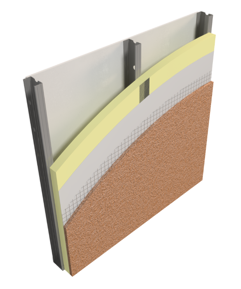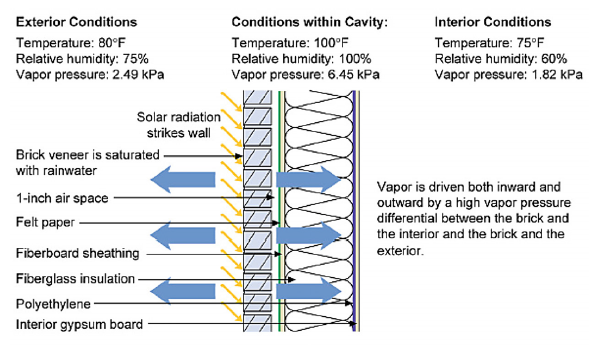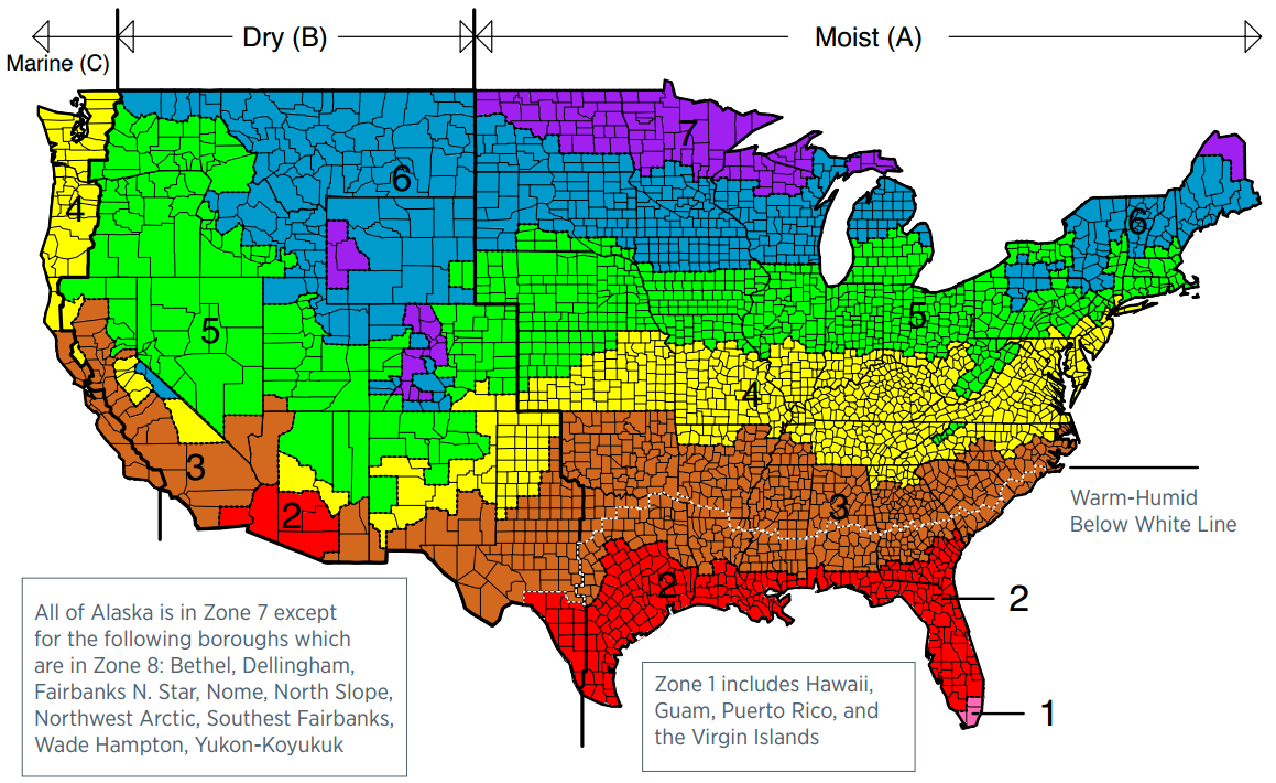 With the publication of the 2021 I-Codes in full swing, it is important to address some very useful improvements and clarifications made to the Portland cement stucco water-resistive barrier (WRB) provisions.
With the publication of the 2021 I-Codes in full swing, it is important to address some very useful improvements and clarifications made to the Portland cement stucco water-resistive barrier (WRB) provisions.
Reservoir claddings, like Portland cement (conventional) stucco, adhered masonry veneers, and anchored brick masonry veneers to name a few, can absorb and store significant amounts of rainwater. When solar-driven drying occurs after a rain event, the inward vapor drives can readily exceed the magnitude of outward vapor drives experienced during the winter (see Figure 1). This can result in elevated exterior sheathing moisture contents and, for buildings that are air-conditioned in the summer, condensation on the interior vapor retarder or high moisture contents in interior finishes. Consequently, some enhanced practices are necessary to protect the moisture-sensitive portions of the wall assembly from wetting due to inward vapor drives.
The 2021 editions of International Building Code (IBC) and International Residential Code (IRC) have effectively responded.
Figure 1. Inward Moisture Movement Due to Reservoir Cladding and Solar Radiation. Click to enlarge. For additional information, visit Continuous Insulation's Water Vapor Control web page.
In a traditionally successful approach, the reservoir cladding is back-ventilated to help remove the water vapor being driven inward as the cladding attempts to dry both inward and outward (see Figure 1). This is the long-standing practice employed with anchored brick masonry veneer by use of a 1-inch air gap and vent or weep holes in the veneer. In another successful approach commonly used with stucco, inwardly-driven water vapor can be blocked by placing an “intervening layer” of low vapor permeance “non-water absorbing” material between the reservoir cladding and the remainder of the wall assembly.
Foam sheathing continuous insulation is commonly used for this purpose and, in colder climates, it must be used in the appropriate amount in conjunction with an interior vapor retarder to effectively control outward vapor drives during winter. (For more on this, refer to continuousinsultation.org’s Water Vapor Control page and wood- and steel-frame wall calculators. These resources and the calculator tool provide a means to coordinate advancements in the 2021 IBC and IRC water vapor retarder provisions and the IECC energy code.)
Finally, in rainy climates, it is important to provide at least a small drainage gap and pathway to efficiently remove bulk water from rain intrusion through the reservoir cladding that would otherwise add to the inwardly-driven water vapor load. This gap also allows for what is known as “hygric re-distribution.” (For more information, please refer to the BSC article: “Drain the Rain…On the Plane…the drainage plane.”)
The 2021 IBC and IRC code improvements to address the above principles are shown in Figure 2 below (only the IBC text is shown; the IRC text is identical). The requirements also vary according to “dry” or “moist” and “marine” climate zones shown in Figure 3.
2510.6 Water-resistive barriers. Water-resistive barriers shall be installed as required in Section 1403.2 and, where applied over wood-based sheathing, shall comply with Section 2510.6.1 or Section 2510.6.2.
2510.6.1 Dry climates. One of the following shall apply for dry (B) climate zones:
- The water-resistive barrier shall be two layers of 10-minute Grade D paper or have a water resistance equal to or greater than two layers of water-resistive barrier complying with ASTM E2556, Type I. The individual layers shall be installed independently such that each layer provides a separate continuous plane and any flashing, installed in accordance with Section 1404.4 and intended to drain to the water-resistive barrier, is directed between the layers.
- The water-resistive barrier shall be 60-minute Grade D paper or have a water resistance equal to or greater than one layer of water-resistive barrier complying with ASTM E2556, Type II. The water-resistive barrier shall be separated from the stucco by a layer of foam plastic insulating sheathing or other non-water absorbing layer.
2510.6.2 Moist or marine climates. In moist (A) or marine (C) climate zones, water-resistive barrier shall comply with of one of the following:
- In addition to complying with Item 1 or 2 of Section 2510.6.1, a minimum 3/16 inch (4.8 mm) space shall be added to the exterior side of the water-resistive barrier.
- In addition to complying with Item 2 of Section 2510.6.1, a space with a minimum drainage efficiency of 90% as measured in accordance with ASTM E2273 or Annex A2 of ASTM E2925 is added to the exterior side of the water-resistive barrier.
Figure 2. 2021 IBC Stucco WRB Provisions
Figure 3. U.S. Climate Zone Map (also to be updated for the 2021 I-Codes) Click to enlarge. For additional information, visit Continuous Insulation's Water Vapor Control web page.
These improved provisions do two very important things consistent with the above-described principles. First, they allow traditional practices to continue where they have been successful in the “dry” climate zones (see Section 2510.6.1 in Figure 2 and Figure 3 for the “dry” climate region). They also clarify that the nebulous intervening “non-water absorbing layer” placed between the stucco and the WRB layer was always intended to be applied to materials like foam plastic insulating sheathing (see Section 2510.6.1 option #2 in Figure 2).

In addition, the traditional WRB requirement in option #2 (i.e., 60-min Grade D paper) is clarified to allow the use of alternative WRB materials with at least equivalent water resistance of ASTM E2556 Type II, such as various building wrap materials. This also provides flexibility to use other materials like some foam sheathing products to serve as the WRB layer if they are approved for that purpose and have a water-resistance equivalent to ASTM E2556 Type II. However, in this latter case, a separate bond-break or non-water absorbing layer must be applied over the foam sheathing WRB as shown in Figure 4 (i.e., the foam sheathing is used as the WRB, not as the intervening non-water absorbing layer). In both cases, as a WRB layer or as an intervening “non-water absorbing” layer, the foam sheathing also serves as a “block” or retarder to inward water vapor movement from the stucco.
Second, the new code language provides additional enhancements that are required for use of stucco in the “moist” and “marine” climate zones (see Section 2510.6.2 in Figure 2 and Figure 3). There are two options for compliance: (1) use of a prescribed minimum 3/16-inch-thick drainage space to the exterior side of the water resistive barrier (behind the stucco) or (2) a space with a minimum drainage efficiency of 90% as measured in accordance with two commonly used ASTM standards.
In addition to a simple prescriptive solution, this new language allows for performance-based solutions that involve the use of proprietary drainage materials and methods, such as grooved foam sheathing, drainage mats, or building wraps that provide adequate drainage space or drainage performance. This practice will help to mitigate moisture issues that have occurred behind stucco and adhered veneers (i.e., reservoir claddings) in moist regions of the U.S.
It should be noted, however, that the above provisions only apply where wood-based sheathing is used on the exterior side of a wall supporting the stucco (consistent with prior editions of the IBC and IRC). Thus, for all other sheathing materials (regardless of their moisture sensitivity) the only thing the code continues to require is a WRB behind the stucco (without a drainage space) in any climate and irrespective of the amount of rain or moisture hazard. For other types of sheathing that are sensitive to moisture, it is recommended that the provisions aimed at wood-based sheathing be used, even though not required by the code.

